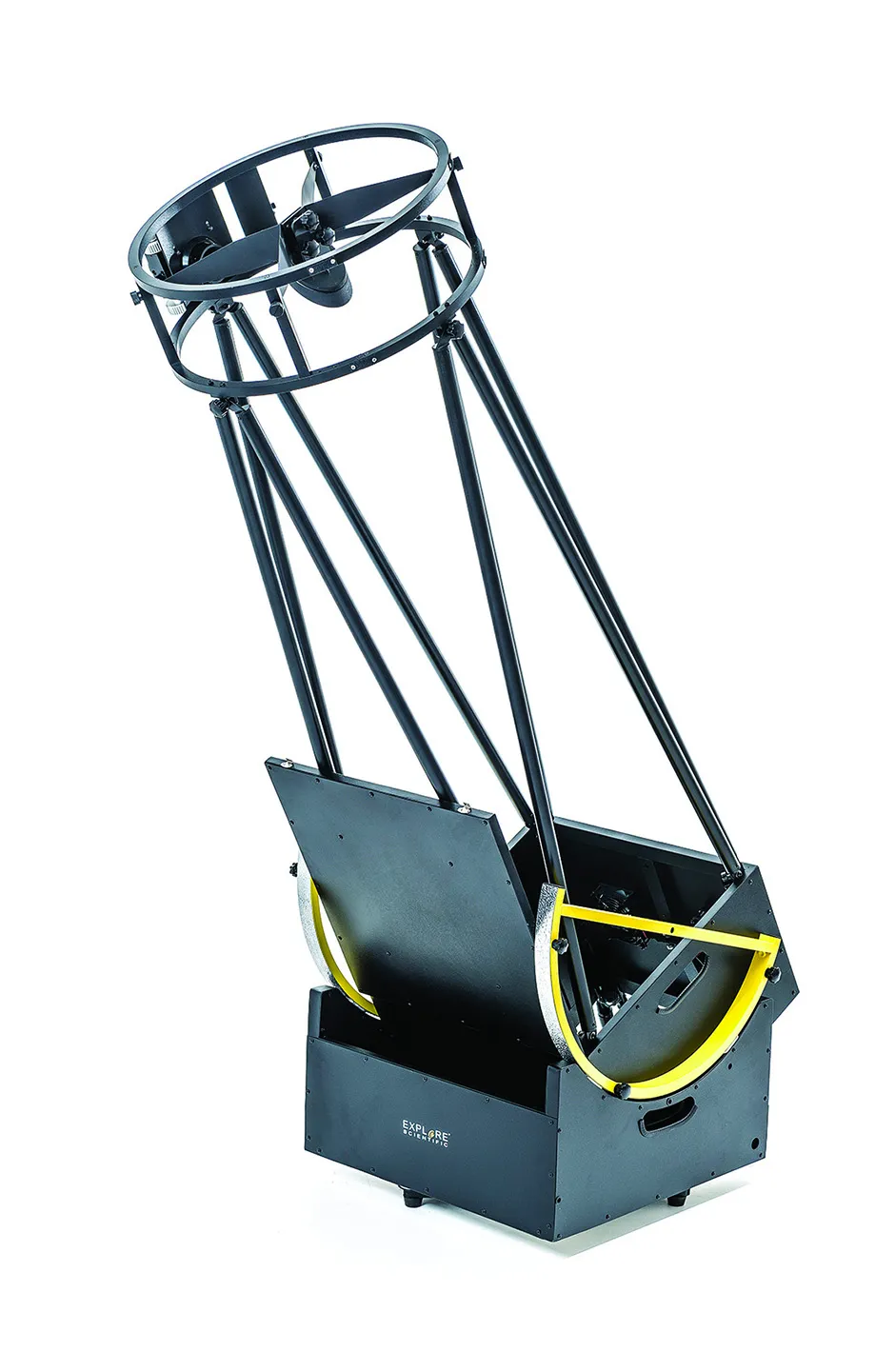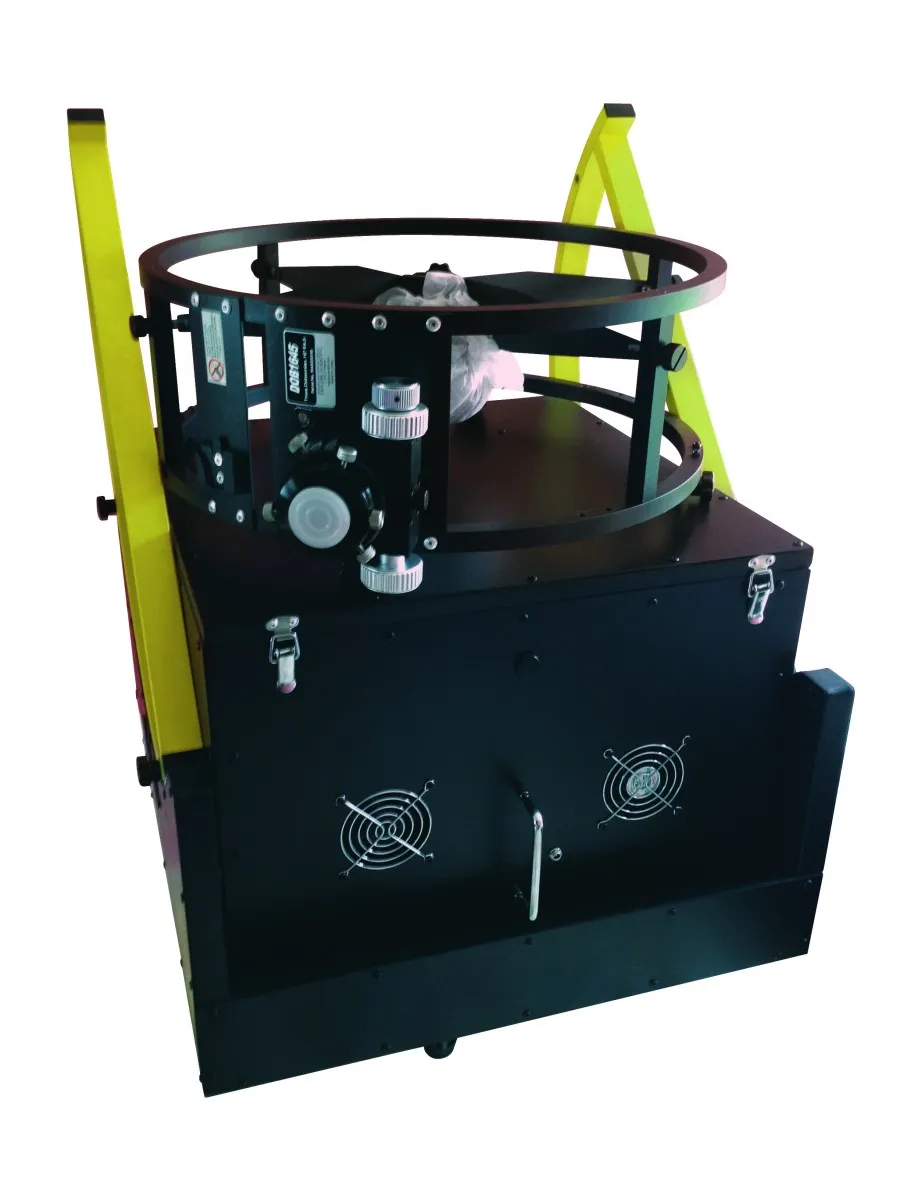Price: £1664.00
Aperture: 406mm (16 inches)
Focal Length: f/4.5
Weight: 38.4kg
Supplier: Telescope House
Telephone: 01342 837908
Website: www.telescopehouse.com
Dobsonians remain a firm favourite with amateur astronomers seeking manageable and affordable large aperture telescopes.
Though the simple altaz design of the Dobsonian mount has seen many refinements over the years, at its heart it is still an incredible piece of engineering.
This 16-inch truss tube offering from Explore Scientific is shipped in one box, with the rocker and mirror box pre-assembled and the other components ready to fit together by way of thumbscrews.
While many commercial Dobsonians use rolled steel tubes and wooden rocker boxes, for this instrument they have been constructed from aluminium.
The low-profile square design of the rocker and mirror boxes allows for a very strong and remarkably efficient system indeed.
This is great if you want to travel to a darker location for a night’s observing or have limited storage space.
The 16-inch primary mirror is made from BK-7 glass and has a focal length of 1,826mm, giving a focal ratio of f/4.5 –a short focal length for its size.

The dual-speed 1:10 rack and pinion focuser is well made and can easily support heavier eyepieces.
The unit felt very responsive with no image shift in use with a range of eyepieces.
An extension for the drawtube is supplied.
Our initial assembly progressed slowly at first, as some of the internal threads were poorly cut on our review scope, but once rectified we were able to put the telescope together with relative ease.
The instrument has clearly been designed so it can be assembled by one person.
Although we found this a little tricky at first, after a couple of times it was no trouble at all.
We took the telescope out under the night sky with our own eyepieces, as none are supplied out of the box.
Allowing the optics to reach ambient temperature for optimum performance can often take quite a while with larger optics, but the in-built cooling fans allowed the telescope to cool down sufficiently in less than 30 minutes.
These fans are powered by eight D batteries (not supplied); their battery box can be strapped to the body of the telescope.
Unusual collimation
Collimation out of the box was close, but did need minor adjustment.
Aligning the optics only took a matter of minutes.
Primary mirror adjustments are made from the front of the mirror using the supplied long-reach collimation tool.
Care needed to be taken to avoid touching the mirror’s surface, but aside from that this method proved remarkably quick and effective.
Secondary adjustments are made with large thumbscrews located behind the secondary mirror mount and, while unusual, they worked extremely well, enabling the whole operation to be carried out while still at the eyepiece.
Once cooled and collimated, we aimed the telescope at the Orion Nebula, M42.
With a 30mm eyepiece we were greeted with a wonderfully rich view of the nebula and the stars in the centre.
We then increased the magnification and moved on to Jupiter, revealing plenty of contrast and detail on the bright planet.
Framed by the four Galilean moons, Jupiter was an impressive sight even though seeing conditions were relatively poor.
However, we did find accurately sighting the telescope quite tricky, as the supplied red-dot finder was not very sturdy.
Once a target was centred, the large wheels and base-bearing surface ensured a positive movement, enabling smooth and accurate tracking and good balance.
Overall this instrument was a pleasure to use, though the finishing touches on the telescope weren’t as good as they could have been – giving it a more of a ‘prototype’ feel.
Yet these can be considered minor issues as it is extremely practical.
The excellent optical performance and compact, lightweight nature of this Explore Scientific Dobsonian remain true to John Dobson’s original design ethos while also giving a design update and superb performance.

Easy to put up, easy to take down
Larger aperture Dobsonian telescopes can be difficult to manage in terms of assembly, storage and transport, but this instrument is amazingly compact and portable for its class.
Its mirror box footprint of 55x55cm is tiny in comparison to many other 16-inch Dobsonians.
We found that it could be easily carried through doors, and would even sit on the back seat of many cars.
The box also has a hinged lid, ensuring that the mirror inside is protected when stored.
The low-profile head assembly is constructed from the same aluminium profile as the mirror box and rocker box, so is exceptionally light and easy to handle.
We found that even after transporting and assembling the telescope several times, the optics required only minor adjustment.
Throughout its design and construction, practicality seems to be the key.
Lightweight materials coupled with basic construction techniques have really made the telescope very usable indeed.
Focuser
The supplied 2-inch rack and pinion focuser has a 1:10 reduction for fine focus.
The drawtube can also unscrew to accommodate the supplied extension barrel.
Primary collimation
Adjustments to the alignment of the primary mirror are made from the front of the mirror cell rather than behind it.
This enables accurate collimation to be achieved more quickly, and without having to step away from the eyepiece.
Doing this requires a special tool, which is supplied.
Secondary collimation
No tools are needed to collimate the secondary mirror.
Adjustments are made via thumbscrews located behind the assembly, rather than the traditional point of directly above.
This innovative approach allows easy access while reducing the risk of anything falling onto the primary mirror.
Altitude wheels
The large altitude wheels proved to be really useful.
Making small movements at high magnification can be difficult with telescopes of this size, but the larger diameter trunnions not only provide a smooth and positive feel but also aid balance when using a range of eyepieces.
Cooling fans
The mirror box houses two battery operated fans: one ‘pushes’ cold air into the mirror box and across the surface of the mirror, while the other ‘pulls’ warm air out.
The fans were quiet and effective in operation.
This review originally appeared in the June 2015 issue of BBC Sky at Night Magazine.
